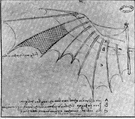The Notebooks of Leonardo
Part 1: The How and the Why The popular perception of Leonardo Da Vinci is that of a painter, the genius who gave the world the Mona Lisa and The Last Supper. Leonardo, in fact, spent far more of his lifetime on scientific inquiry and writing in his notebooks than he ever did on painting. It is a testament to his brilliance that two of the most widely recognizable works of art in the history of the world were done “in his spare time.” Leonardo was a curious man. He always had been, from his earliest experiences growing up in what was then not a united Italy. He dared to ask questions that the big brains of his time hadn’t even thought of yet, and he cataloged all of his inquiries in meticulous detail in a series of notebooks, only a third of which still exist.
A visual man by nature, Leonardo drew illustrations almost more than he wrote in his notebooks. And it is the way in which he wrote that has delighted and frustrated historians for generations: He wrote in what is called mirror script, which can be read only by holding the manuscript up to a mirror. Why did he do it that way? Only he knows for sure. They were also written in an obscure dialect and using many abbreviations, making it very difficult for any but the most learned scholars to decipher. The pictures stood for themselves, of course. Next pageThe Future > Page 1, 2 |
|
Social Studies for Kids
copyright 2002–2025
David White



 He set out to write about four major themes in his notebooks: the science of painting, the elements of the mechanics, the particulars of architecture, and the workings of the human body. His innate curiosity drove him to include writings on such other disciplines as botany, geology, hydrology, and even flight. He seemed to have a boundless nature of inquiry; this, coupled with an extraordinary attention to detail and to recording his musings and experiments, has given us the notebooks that remain, 31 in all.
He set out to write about four major themes in his notebooks: the science of painting, the elements of the mechanics, the particulars of architecture, and the workings of the human body. His innate curiosity drove him to include writings on such other disciplines as botany, geology, hydrology, and even flight. He seemed to have a boundless nature of inquiry; this, coupled with an extraordinary attention to detail and to recording his musings and experiments, has given us the notebooks that remain, 31 in all.
